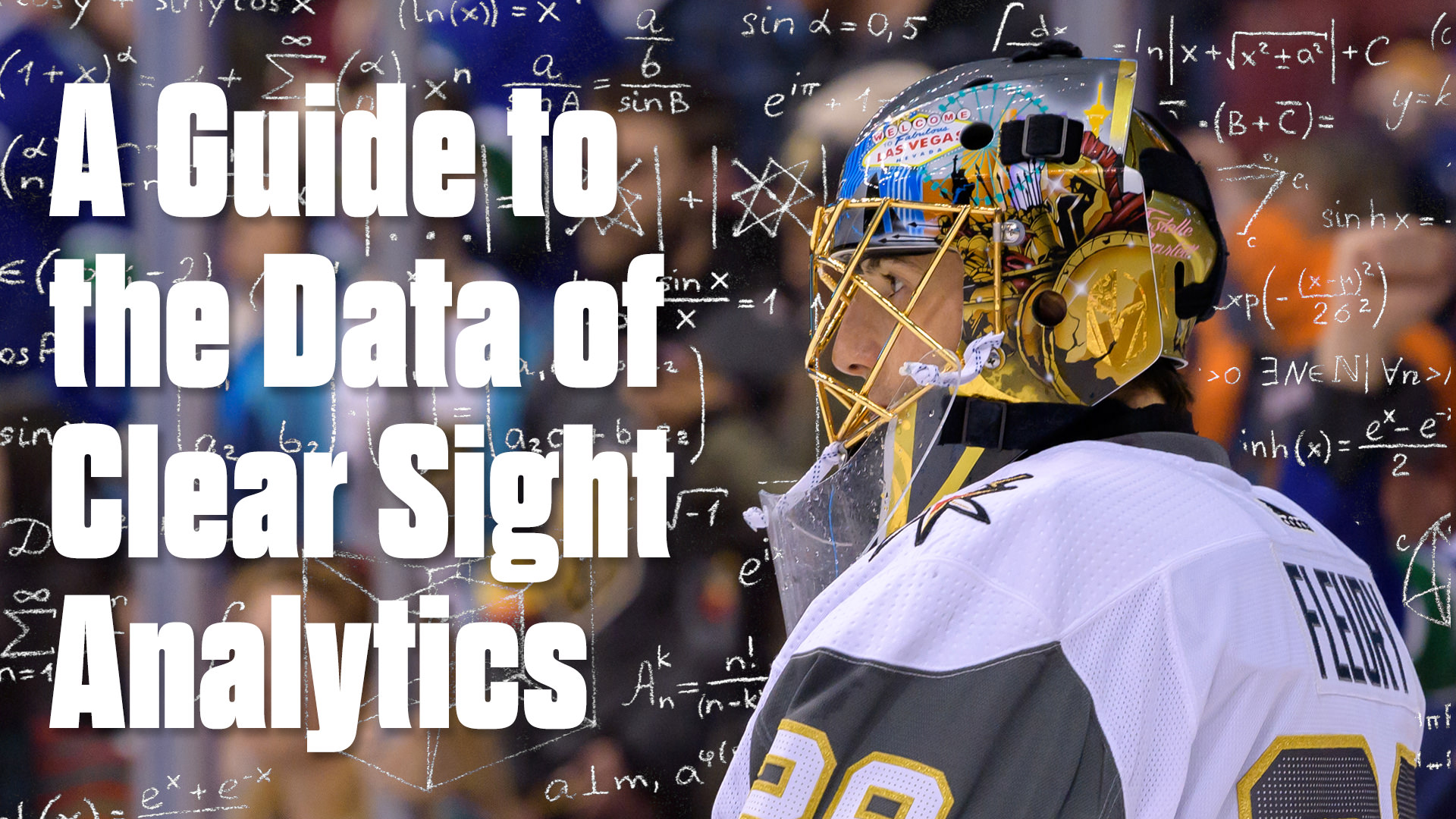Welcome to InGoal Premium

Here at InGoal Magazine, we like to use data provided by Clear Sight Analytics (CSA) whenever possible. The company’s founder, Stephen Valiquette, is a former NHL goaltender who understands what matters most when evaluating data for The Position. This understanding is part of what makes their data uniquely useful for a publication obsessed with goaltenders.
Because their approach departs, both theoretically and practically, from the way the NHL (and many public data sources that rely on the NHL’s play-by-play reports) handles its statistics, and because we use their data so often, we thought it would be useful to provide a basic overview in a stand-alone article, so our readers can reference it whenever they like, rather than seeing the same explanations repeated in every piece.
The Importance of Shot Quality
All goaltenders know that not all shots are created equal. An unscreened wrister from the point is far easier to stop than the same shot with a body in front. Add another body, then another player skating through the goalie’s line of sight as the shot is released, and what could have been an easy save turns into a tough stop.
CSA tracks 34 separate variables on every shot, making theirs the most comprehensive shot-quality tracking system available today. They not only mark where the shot originated, but also what type of shot it was (wrist, backhand, slap, snap), the goalie’s sightlines (screened by an opponent, their own player, both, whether the screen was moving), whether and how the puck was deflected (by their own player or an opponent), and more.
Even more importantly, CSA tracks pre-shot movement, including passes and carries, and the “flow” of the plays that precede each shot: a two-on-one where a player makes a long lateral pass to a teammate is very dangerous. It’s even more dangerous when another long lateral pass follows that, and CSA considers all this in its evaluation of shot quality. Whether a shot comes off the rush, low-to-high, a broken play, or a netback-situation like a wrap-around, CSA notes it.
Such rich detail has enabled CSA to determine how likely a given specific event is to result in a goal. Their massive and ever-expanding database of shots allows them to calculate the goal-likelihood of very specific types of play.
A shot coming off a two-on-one where two long lateral passes are made is, for example, more likely to end in a goal than a breakaway. An unscreened point shot scores on only a tiny fraction of attempts. Goalies know this intuitively, but having the data to confirm precisely how tough one save is likely to be over another is indispensable for anyone who cares about goaltending performance.
The Importance of Accuracy
The aforementioned NHL play-by-play data is useful for many analytical purposes. Unfortunately, its inaccuracies render it less useful when considering smaller sample sizes (like goals scored on an individual goaltender, or saves made in very specific situations, like breakaways or wraparounds).
CSA uses its own tracking system, and verifies each shot. This means that problems in the NHL data with shot type and location are non-issues, so that the picture the data paints is much sharper. Further, CSA verifies that every shot they record is an actual shot on goal – the NHL does not. Also, because CSA employs a single tracking system for every team, issues like “rink bias” (where the shot-counters in a given arena tend to over- or under count shots and distances) disappear.
In addition to simple improvements in accuracy, there’s a meaningful philosophical difference between the way CSA counts shots, and the way the NHL does.
Normally, the league would count a long dump-in from the redline that happened to land on goal as a shot on goal. That’s fair, and technically true, but not very meaningful in terms of a goalie’s performance and abilities: “shots” like those do little more than inflate a goalie’s save percentage.
CSA simply doesn’t count those kinds of incidental, absolute “gimmie” shots as shots on goal. As a result of this decision, and of course more accurate counting of shots, CSA gets closer to the “true” save percentage of a given goaltender, and that number, league wide, is consistently lower than the NHL’s save percentage numbers.
To avoid confusion (because it’s count does not match the NHL’s count), CSA refers to each shot on goal they record as a “scoring chance” or just “chance.” This is very important to remember, so to be absolutely clear:
CSA calls the shots on goal it records “scoring chances” or just “chances.” If they determine a goaltender faced 30 shots on goal in a game, they would say the goaltender faced 30 chances.
Two Vital Statistics: Save Percentage Differential and Goals Against Differential
All of the tracking work detailed above pays off in two very clear and useful statistical summaries of every goaltender’s performance: Save Percentage Differential and Goals Against Differential.
Save Percentage Differential is basically CSA’s version of delta expected save percentage. Based on the quality of all chances faced, CSA determines what a goaltender’s save percentage should be: they compare this to a goaltender’s actual save percentage, and arrive at a positive number (if the goaltender performed better than expected) or a negative number (if a goaltender performed worse).
A goaltender working in a poor defensive environment will have a low expected save percentage; the inverse is true for goalies in great defensive environments. That means goalies from weaker or stronger teams aren’t penalized or rewarded based on their team’s defensive ability – a goalie’s performance above or below their own team’s defensive baseline is what gets counted. For example, a goalie with a Save Percentage Differential of 4 percent has performed well above expectation, whereas a goalie with a score of -4 percent has done abysmally worse than expected.
Goals Against Differential is CSA’s version of goals saved above expected. Based on the quality of chances a given goalie faces, they would be expected to allow a given number of goals (their expected goals against). If a goalie allowed fewer goals than expected, they will have a positive Goals Against Differential. If a goalie allowed more goals than expected, they’d have a negative value. For example, a goalie with a Goals Against Differential of 30 saved their team 30 goals that season over what would have been expected given the quality of all chances faced. A score of -30, on the other hand, would indicate the goalie cost their team 30 goals.
*****
We hope you found this overview helpful and straightforward. If you have any questions, please feel free to ask in the comments, where the answers may be useful to others as well.
Become a Member to Read all our Exclusive Content
Access to this article on Clear Sight Analytics was provided to all readers; however, if you would like access to all of our exclusive content, from features to Pro Reads, Pro Drills and more, we invite you to become an InGoal Magazine Premium Member. Learn more about InGoal Membership here.
We’re working hard to bring you the best exclusive goaltending content whether you play goal, you are a coach, a parent of a goaltender, or a fan of the greatest position in sports.
All InGoal Premium members enjoy an ad-free experience.
Already a member? Log in
Comments
Let's talk goaltending!
We welcome your contribution to the comments on this and all articles at InGoal. We ask that you keep it positive and appropriate for all - this is a community of goaltenders and we're here for each other! See our comment policy for more information.




